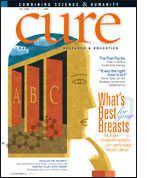Publication
Article
CURE
Planning for Survivorship
Author(s):
The Institute of Medicine’s From Cancer Patient to Cancer Survivor: Lost in Transition offers a number of recommendations for improving survivors’ care.
When the Institute of Medicine published From Cancer Patient to Cancer Survivor: Lost in Transition in 2005, it offered a number of recommendations for improving survivors’ care.
The report’s 17-member committee, along with more than 30 cancer professionals from all parts of the cancer community, recommended, among other things, a comprehensive plan for follow-up care that would detail the nature of the cancer diagnosed, what therapies were given, complications that might ensue, and recommended care for the future. This “care” plan would serve as a guide for the survivor and his or her primary care physician, and it reflects the growing recognition that survivors need to be monitored and treated for long-term and late consequences of cancer throughout their lifetime.
A number of organizations have worked on versions of such a plan, including the Lance Armstrong Foundation, which is looking to the LIVESTRONG Survivorship Center of Excellence Network to come together on a final design that will include a “treatment summary” that the patient has at the end of treatment and a care plan that will help patients understand needed follow-up with their primary care physicians.
Collectively, the centers comprising the Network have different strengths, says Caroline Huffman, senior program officer for LAF.
“The Network is a web of collaborating entities comprising eight regional Centers of Excellence in Cancer Survivorship, which are recognized for their excellence in research, patient care, training, communications, and outreach; and 21 community-based affiliate partners,” says Huffman, explaining that the community-based centers are, for the most part, community hospitals, including those serving traditionally underserved populations.
Huffman says one of the most exciting aspects of the Network is bringing together researchers who are used to working in relative isolation and in competition for funding. “We’ve developed a way for them to communicate with one another to really figure out what it is that they’re strategically going to do that is going to change the field,” she says.
How this affects the goals for the survivorship plan, Huffman says, is that those who have been working on this problem for years are collaborating to find the best solutions for complicated problems with the ultimate goal being to offer an open-source, web-based tool for anyone who wants to create a treatment summary and a care plan.
“All the Network centers are continually assessing what population of survivors needs to be seen, at what junctures they need to be seen, and what’s involved in a survivorship follow-up visit,” Huffman says, adding that the fact that there isn’t an agreed upon comprehensive treatment summary and care plan already available speaks to the complexity of creating one.
“I think that if LAF can do this, it’s really going to be one of the most lasting impacts for LAF and for the Network, but also one of the most meaningful things for survivors as well as practitioners. I truly think it can change the paradigm of care.”






